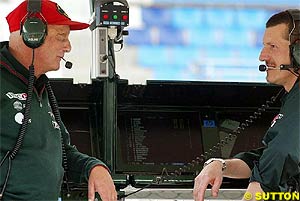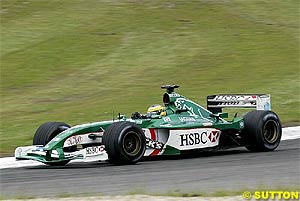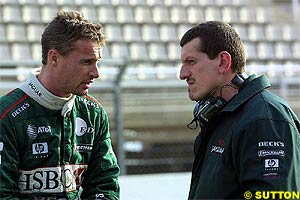
Interview with Guenther Steiner
Atlas F1 GP Correspondent
For nearly four months, the Jaguar team have been looking forward to the introduction of the revised R3B chassis after they decided to stop developing the recalcitrant R3. The time has finally come, and the much modified car will make its debut at Silverstone this weekend. Ahead of the team's most crucial Grand Prix, Atlas F1's Will Gray talked to managing director Guenther Steiner, about what to expect from the R3B, about its predecessor, and about how he plans to take Jaguar to the place where they belong
There are a lot of hopes riding on the latest offering that, according to Irvine, has seen every part of the car "apart from the bit I sit in" overhauled. It is a dramatic and drastic change but, according to Steiner, it is no great shakes compared to what has been modified inside the team.
"There are things that have happened inside that nobody can see from the outside that have improved things," said Steiner. "The car is just the first step in the tool to show how the team is going to work in the future, the first stepping-stone of how we want the team to work.
"We have made significant changes to the team. We swapped people around and we strengthened things, and the biggest change was strengthening the aerodynamics department from 30 people to 50, because we got our own wind tunnel and reorganised the whole thing. In the drawing office, there are a few new people in and a few that left. Technical director Steve Nichols left at the beginning of the year and all over the company there were some changes. Yeah, there were quite a lot of changes - but you do them every day.
"It is not the big thing that one day we have dismissed 50 people or 20 people. We never did this. Now we have to grow a company, so there are quite a lot of changes. It has grown by about ten people at the moment, but not more, because some people left and some came in.
"We just need stronger people, better people. But it is not that we need them from outside. We need to give people the strength. That is the management's responsibility, to bring people up to speed."
Such a fact seems astonishing. The Ford-backed outfit developed from the low-budget Stewart team, but the addition of big money which led to a massive staff expansion seems to have done more harm than good.
In their three years of existence, the Stewart team had scored one victory finished fourth in the Championship and, as Jordan had in their debut year, they had shown that being small is not necessarily a disadvantage. Much was expected when the team turned to Jaguar.
But constant management changes, which ironically began with the resignation of original team chief Jackie Stewart on the very day the team were launched and included Bobby Rahal, have prevented major steps being made. The new order of former racer Niki Lauda and organiser Steiner have taken the helm. Irvine believes in them, but it is the performance the latest car is what will seal their fate.
Steiner is quick to point out that it is not a 'new' car, but a heavily modified version of the R3. Perhaps, however, time will prove that the team should have ditched the original drawings and created an all-new machine. The pressure is on, and the team have, perhaps a little unwisely, pumped up the expectations that have left fans and Ford bosses alike, all waiting with bated breath for the 'new' machine to show everybody just what Jaguar can do.
"It is not a new car, it is a revised car," Steiner insisted as he began to explain what should be expected of the latest Jaguar machine. "The chassis is the same, the control systems, the engine and gearbox are all the same.
"It will be very important for the whole team," he continued. "For the morale, to see our capabilities, and so on. You can always get something good out of it even if it doesn't work. We might understand our wind tunnel better or our testing methods, it is still a step forward because we have made a step forward in the organisation with this programme. We can get something out of it."
The team considered reverting to last year's R2 car after the first couple of races this season, but they ditched that idea and decided to use the R3 as a base from which to build.
In Brazil, Irvine was confident that the team would introduce modifications to move him "significantly" up the grid by the time the Formula One circus arrived in Europe. Those changes did not happen, and Irvine admitted that the team did not understand how to improve the car.
Nothing they tried in testing could take the performance on a step so they went back to the drawing board and, with the help of their new wind tunnel, just down the road from their Milton Keynes factory, they began their dramatic aerodynamics overhaul.
Steiner now admits that the performance of the R3 was his "biggest shock" and added: "When we tested R3 for the first time, we realised where we were. The aero work wasn't done. There were a lot of mistakes made on the design.
"I don't want to go into details, I think that is the past and we have to think about the future. I don't want to go back and say this was done wrong, who did this wrong, it's not relevant to me. We have to sort it out and let the past be the past and think about the future."
Irvine is confident that the new team, the new wind tunnel, and the new package will all help the team move forward, but the fact that he has been saying so for the last four races has put a great pressure on the team to perform.
"There is pressure," admitted Steiner. "It is a little bit dangerous, but we are realistic. I am not saying how much better it is because I don't know. It is other people that say it is a new package and it must be so much better. You always like to hear the good things.
"We are trying to take expectations down, it is the people which pump them up. It is Formula One, it is normal. I think everybody wants to see Jaguar going well. I don't think Eddie is pumping it up. It is nice to believe it is going to be good for a driver. From his point of view it is quite depressing going around the way we are at the moment."
The downcast Ulsterman has admitted that he currently goes to races knowing that he will struggle to perform and just waiting for Sunday to come so he can go home. So what will it do to Jaguar's star driver if the car comes out the box and flies?
"Just a good car will not make him happy," said Steiner. "He needs to see there is something behind it and that is what we are trying to show him. At the moment we have to do more than him. He is not the weak link at the moment, it is us.
"We didn't do anything new on the car for six races, so it is a little bit frustrating but he understands exactly what we are trying to do. We are trying to do a good development instead of giving him illusions. He believes in what we are doing and sure, if he had nothing new, why should he be excited? We all hope it puts a smile back on his face and if he is smiling I can smile. It is very difficult to see the car get worse."
But as the very astute Steiner points out, the development of the team internally is just important as the development of the car, and it is clear that there were some problems within the team that hampered their progress. Steiner admitted that he is currently faced with the challenge of cutting out 'in-fighting' throughout the team, which appears to be the root cause for Jaguar's poor performance.
Teamwork, as Ferrari have shown, is crucial for success, but as the very public departure of former boss Rahal and Irvine's continued jibes at the American team chief show, all was not sweetness and light at Jaguar in the past. To move forward, all that fighting must be cut out.
"I think that is one of the jobs that we are doing but it takes time," said Steiner. "You cannot go in one morning and say, 'Oh, now you are all friends, you have to work together, we are a team' and so on. It is a culture and it needs to form.
"It took a few years to get where Jaguar is and it will take a few years to get going in the other direction, so this is the challenge, to bring the team together. Things seem to be starting to work, but it is hard work to push this all the time. You cannot just tell somebody 'you have to get on now very well with him and you will do this and he will do that'. It doesn't work like this.
"I wouldn't say there are big conflicts. There is always a little bit of friction, and it is nothing more than expected. I had actually expected there would be more conflict when we brought all the new aero people in an it seems they have worked as a team and there is not a big problem. But you cannot always have a complete happy family all the time."
But, unfortunately for Jaguar, it seems that much of that 'unhappy' family has remained with the team because of the need to expand the wind tunnel department so dramatically.
"It is a much stronger group," Steiner defended. "There is almost everybody still there, but we re-organised the whole department because before they had two weeks every month in California an now we have every day testing in the wind tunnel.
"We needed more people, and good people, to bring this forward, and that's what we did. But not many of the aero department has left because we still need to do the work whatever we want because we have got more time now in the wind tunnel so we need to do more work and you need the people to do that.
"Half the problem, it wasn't the people it was maybe the circumstance the people were given to do the job, and that was management decisions which were not right. We now have groups of aerodynamicists. They change. There are four groups which swap over all the time because we are doing two shifts. They come back to the office, do their homework, then go for one week into the wind tunnel."
That change, according to Steiner, is the beginning of a new order at Jaguar. More organisation and more teamwork, in his theory, should lead to more success and more points. But it is not an overnight exchange. As he said before, it is a culture that needs to be altered, and it is his job to alter it. Whether Irvine is part of that grand Steiner plan, or Lauda for that matter, remains to be seen.
But whatever you do, don't think that it's the end of the line for Jaguar if the 'new' car's debut at Silverstone this weekend fizzles into a disappointing failure. This is, according to Steiner, just the beginning of the Jaguar future.
Jaguar will face the ultimate public test this week when they race their much-modified R3 car for the first time, at Silverstone at their 'home' Grand Prix. Heads will roll if it does not perform, but Ulsterman Eddie Irvine believes that the team are now set up to do the business. And he puts much of that hope down to one man.
 According to Irvine, former Ford rally chief and now Jaguar managing director Guenther Steiner is the star man and the man who has made the changes that will turn around Jaguar's fortunes for not only this season but for the future.
According to Irvine, former Ford rally chief and now Jaguar managing director Guenther Steiner is the star man and the man who has made the changes that will turn around Jaguar's fortunes for not only this season but for the future.
 The team have been constantly changing since they started their quest for glory in Formula One, and one thing it desperately needs is a bit of stability. So far, since their high-profile debut in Melbourne 2000, every year has been a flop. They have scored only one podium finish, for Eddie Irvine's third place in Monaco last year.
The team have been constantly changing since they started their quest for glory in Formula One, and one thing it desperately needs is a bit of stability. So far, since their high-profile debut in Melbourne 2000, every year has been a flop. They have scored only one podium finish, for Eddie Irvine's third place in Monaco last year.
 Irvine has laid all his hopes, and possibly even his Formula One future, on the modified car and has directed all questions about performance since the opening three races towards the team's decision to 'give up' with the R3 just months after its arrival.
Irvine has laid all his hopes, and possibly even his Formula One future, on the modified car and has directed all questions about performance since the opening three races towards the team's decision to 'give up' with the R3 just months after its arrival.
 Despite the depression, Irvine has remained upbeat so far this year. He seems to have convinced himself that the team will make a gigantic turn-around with the new package, and he will soon be able to race again.
Despite the depression, Irvine has remained upbeat so far this year. He seems to have convinced himself that the team will make a gigantic turn-around with the new package, and he will soon be able to race again.
 Sometimes, the best thing to do with a car when it seems to have gone in the wrong direction is to rip up the drawings and start again. But with the same team of brains in a different order, how different can the same group make the new package?
Sometimes, the best thing to do with a car when it seems to have gone in the wrong direction is to rip up the drawings and start again. But with the same team of brains in a different order, how different can the same group make the new package?
Please Contact Us for permission to republish this or any other material from Atlas F1.
|
Volume 8, Issue 27
Atlas F1 Exclusive
Interview with Guenther Steiner
Jo Ramirez: a Racing Man
Articles
Trust and Trulli
British GP Preview
British GP Preview
Local History: British GP
Facts, Stats & Memoirs
Columns
British GP Quiz
Bookworm Critique
Elsewhere in Racing
The Grapevine
> Homepage |